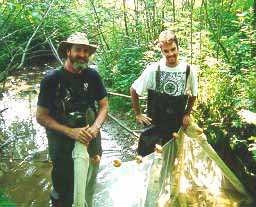Research with Kenyon Students
|
 |
General topics
I have collaborated with students in two areas of research, linked conceptually by the process of dispersal
of individuals within and between populations. These two areas are the ecology of seed dispersal by ants, and the
population structure of fish in headwater streams.
Ants disperse seeds of many plants. In Ohio, many of these plants flower in the early spring in the understory
of moist forests; up to two-thirds of these spring-flowering, understory perennials produce seeds with special,
external fat bodies. Ants respond to these seeds by carrying them back to nests, where the fat bodies are consumed
before the "cleaned" seeds are abandoned or dumped outside the ant nest. What behavioral cues stimulate
carrying behavior? Why do ants often stop carrying this kind of food before the seed supply is depleted? How is
gene exchange among plants influenced by short (1 to 3 meters) dispersal distances? Is plant recruitment limited
by competition for the services of ants? Do ant colonies produce more workers or reproductives if they have access
to such seeds? We use field monitoring, experimental methods, and spatial modeling to address these questions.
In headwater streams, fish populations are distributed in a "linear" ecosystem, which raises questions
about free exchange of genes through a watershed. Does the amount of gene exchange allow fish to adapt to the local
selection pressures imposed by different land use patterns? This is an important question because headwater streams
are especially influenced by the materials flowing into them from surrounding land - the aquatic and terrestrial
ecosystems are linked intimately. In Knox County, Ohio, agricultural practices are highly varied, but of sufficient
quality to allow the Kokosing River to be designated an Ohio Scenic River. We are looking for genetic markers to
allow us to detect potential problems in headwater streams, and we are using genetic markers to better understand
the population structure of fish in linear, non-equilibrium systems such as the Kokosing River watershed. Depending
on whether we wish to examine potential response to selection or to measure fine-scale genetic structure, we use
allozyme markers or RAPDs analysis. In addition, we use laboratory studies to test for response to selection.
Some papers and abstracts with student co-authors
- Skidmore, B. and E. R. Heithaus. 1988. Chemical inducers of seed dispersal by ants from Hepatica americana.
Chemical Ecology 14:2183-2194.
- Morales, M. A. and E. R. Heithaus. 1998. Food gained from seed dispersal mutualism shifts sex ratios in colonies
of the ant, Aphaenogaster rudis. Ecology 79:734-739.
- Mitchell, C., L. Blumer, and E. R. Heithaus. 1990. The genetic structure of the mottled sculpin, Cottus
bairdii. Ohio Journal of Science 90(2):68.
- Stephens, L., and E. R. Heithaus. 1991. How density and dispersal influence inbreeding in Trillium grandiflorum.
Ohio Journal of Science 91(2):71.
- Cummings, K., and E. R. Heithaus. 1992. Changing response of ants to myrmecochorous seeds. Ohio Journal of
Science 92(2): 59.
- Liu, S. Y., and E. R. Heithaus. 1993. Carrying response and satiation of ants to seeds and insects. Ohio Journal
of Science 93(2): 46.
- Rice, S. D., and E. R. Heithaus. 1993. Aphaenogaster rudis response to oleic acid and an evaluation
of satiation effect on seed dispersal. Ohio Journal of Science 93(2): 46.
- Liu, S. Y., and E. R. Heithaus. 1994. Foraging responses by Aphaenogaster rudis to variable food rewards
on seeds of Sanguinaria canadensis. Ohio Journal of Science 94(2): 23.
- Morales, M. A., and E. R. Heithaus. 1994. The effects of Sanguinaria canadensis elaiosomes on population
dynamics of Aphaenogaster rudis. Ohio Journal of Science 94(2): 23.
- Myers, M. C., E. R. Heithaus, and P. A. Heithaus. 1996. Genetic responses of fish in small streams to landscape
variation. Ohio Journal of Science 96(2): 19.
- Heithaus, E. R., and J. M. Bono. 1998. Caste allocation of radio-labeled food in colonies of the ant, Aphaenogaster
rudis. Ohio Journal of Science 98(1): 13.
- Kysela, D. T., and E. R. Heithaus. 1998. Gene flow and population structure in Etheostoma caeruleum.
Ohio Journal of Science 98(1): 7.
- Holman, M. L., and E. R. Heithaus. 1999. Are caste ratios in Aphaenogaster rudis sensitive to resource abundance?
Ohio Journal of Science 99(1): A-20.
- Santangelo, M. L., and E. R. Heithaus. 1999. Heat tolerance in Rhinicthys atratulus and microhabitat variation
in temperature in headwater streams in Knox Co., Ohio. Ohio Journal of Science 99(1): A
- Bono, J. M., and E. R. Heithaus. 2002 (in press) Sex ratios and the distribution of elaiosomes in colonies
of the ant, Aphaenogaster rudis. Insectes Sociaux.
- Heithaus, E. R., and M. Humes. 2002 (in press) Variation in communities of seed-dispersing ants in habitats
with different disturbance in Knox County, Ohio. Ohio Journal of Science.
Comments or Suggestions to: Ray
Heithaus at heithaus@kenyon.edu
Edited: 8/16/02
 Biology
Homepage
Biology
Homepage  Back
to Kenyon Back to Biology Faculty Page
Back
to Kenyon Back to Biology Faculty Page
 Biology
Homepage
Biology
Homepage